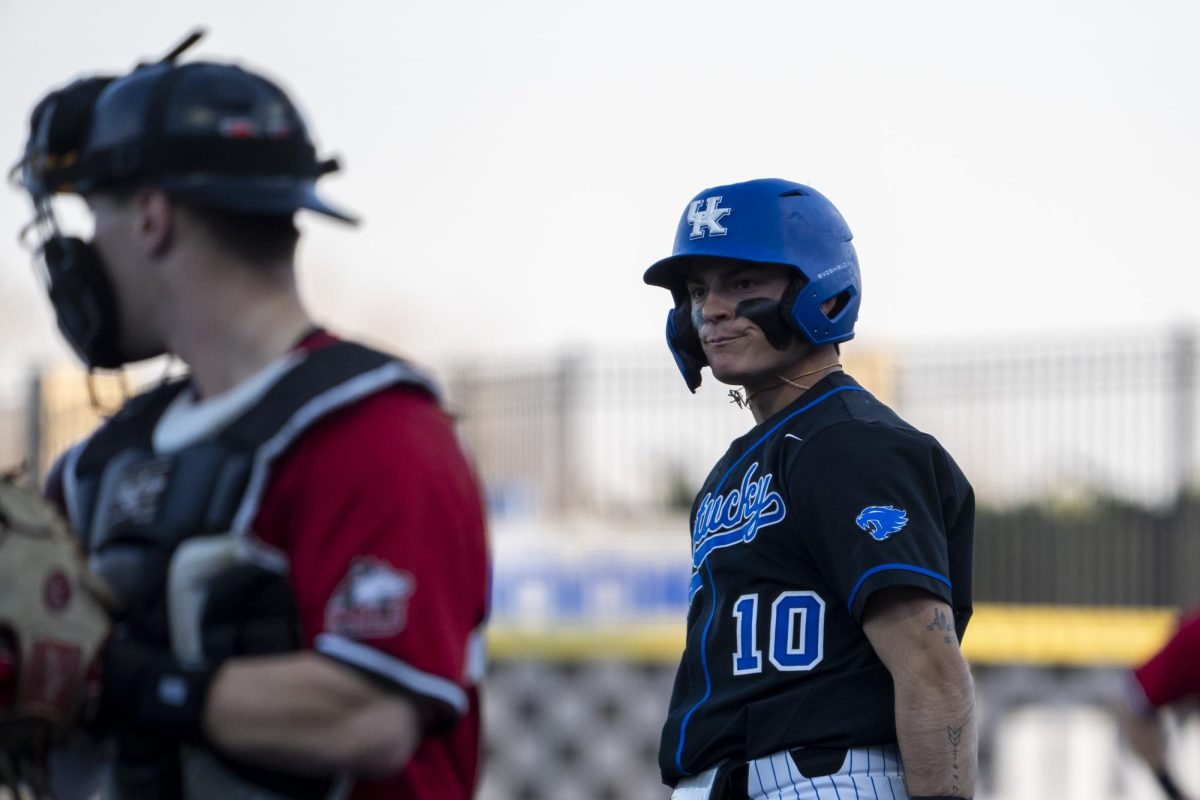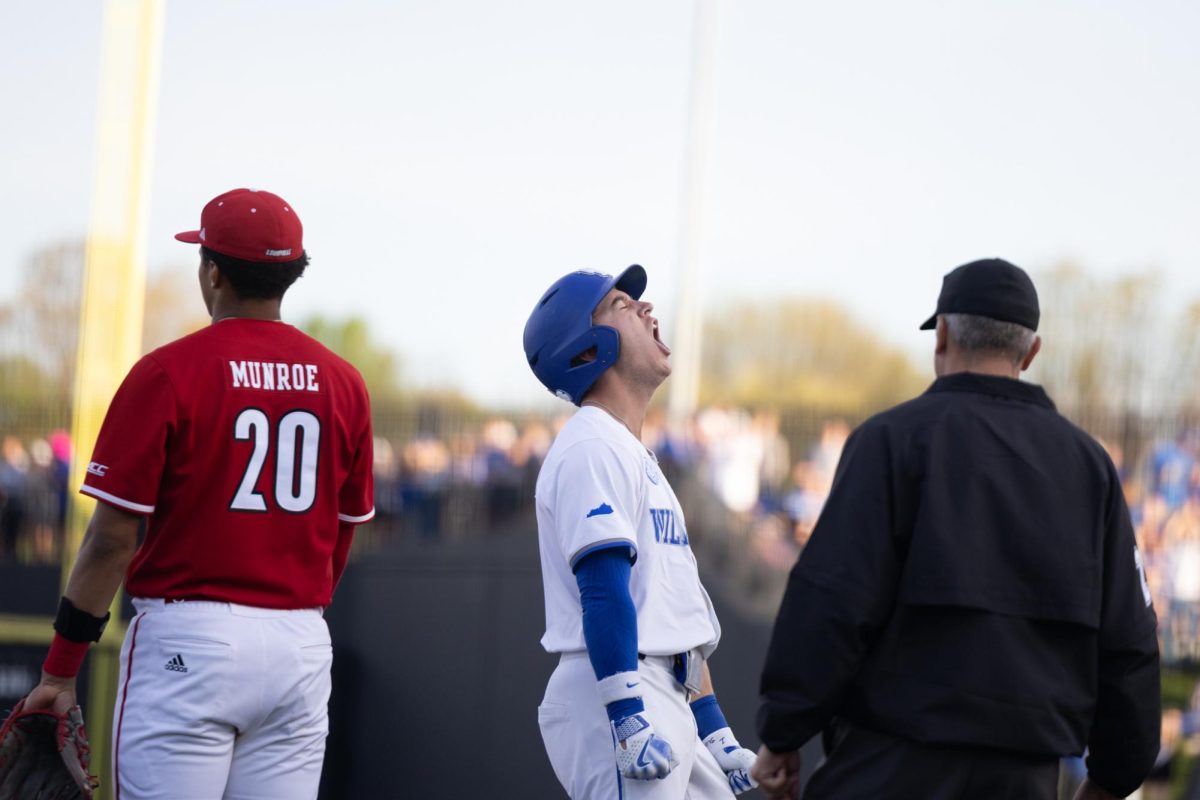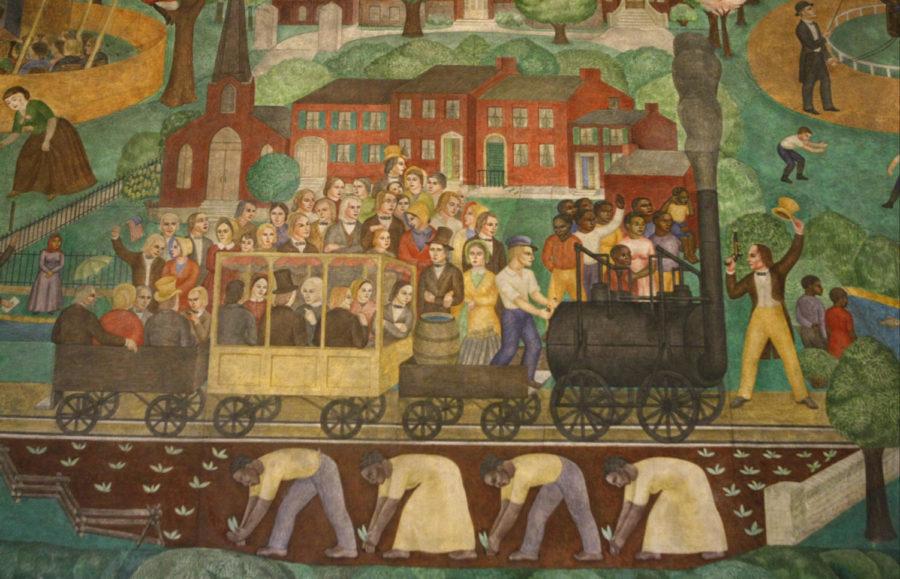Op-ed: BSU president responds to artist’s call to not remove mural
The mural inside Memorial Hall was created by Anne Rice O’Hanlon in 1934. Photo by Joel Repoley | Staff File Photo
April 10, 2019
Dear University of Kentucky community,
Addressing our histories and exposing our realities too often comes at the price of Black trauma, Black community setbacks, and the death of Black people. This does not have to happen and it will stop happening on this campus, our campus. Removing the mural allows space for healing in a location that is meant for celebration and jubilation. Let it be just that. We are making the choice to confront the legacies of this campus. Confronting these legacies and creating systemic change requires the collective energy of our entire community. We need space and time to heal after these confrontations. Memorial Hall is a location on campus currently earmarked for academic classes and many celebratory events. It is one of two easily accessible spaces for student organizations to hold celebratory events such as probates and step shows. How can we celebrate and heal in a space that carries such trauma for so many students? Taking down and completely removing the mural is not with the purpose of destroying art or covering up necessary conversations, but with the intent of giving Black students room to heal.
Technically, Memorial Hall is a building meant to celebrate history. It is correct to say Black people are and have always been a part of Kentucky’s history. If we want to celebrate them, then why can we not paint the hidden stories of Black people in Kentucky? Why not paint the stories of Dr. Thomas T. Wendell, Charles Henry Parrish, Lucy Harth Smith, Rufus B. Atwood, Lyman T. Johnson? There are so many ways in which we can depict the history of Kentucky, including slaves or those who survived slavery. Slavery is not monolithic to depicting our ancestors in bondage. The Black students attending the University of Kentucky refuse to be slaves anymore. We refuse to be traumatized. We refuse to allow our ancestors to be plagued with false narratives. If the university is so eager to depict slavery, then let them depict it truly. Give no attention to romanticized and falsified history. Better yet, show us inspirational images of slaves who freed themselves and went on to achieve more. Why must the slaves in art remain as slaves forever?
READ: Artist who created piece in response to Memorial Hall mural writes letter to UK community
Ms. Olivier has noted that O’Hanlon’s mural cannot be compared to Confederate statues because they were created to intimidate and remind Blacks that white supremacy lives on in the hearts of certain men. Last week, the day after the mural was covered, April 3, 2019, a community member had the audacity to post a sign on the covered mural that read, “Keep the Mural!” Last week, a student was found, posting on social media, “F*** N***ers,” “N***ers should die,” and in black face. The Confederate statues were not just meant to intimidate; they were meant to inspire future generations to act out of hate. Non-Black and Non-Native students, faculty, and staff at this institution are inspired to hate, to be openly racist, and to openly discriminate against us because the mural is sign from the university that they will be supported, protected, and celebrated for doing so. O’Hanlon’s mural is absolutely equitable in this since.
Ms. Olivier has also noted the four subjugated people in the middle of the mural. You see the slaves as linchpins, we see them as lynched. We see our ancestors in perpetual slavery. Perhaps you interpret the art in a way that depicts slaves as building Kentucky. Others interpret this, putting four slaves in the center of the art piece so that as you open the doors to a celebratory hall your focus goes to them, as making sure that you can never escape slavery. Black students, viewing this mural, can never escape slavery. On this predominantly white campus, we will always feel pressure to code-switch, hide our hair, watch our backs, and endure racist hate speech. It stares at us, and we back at it every day. While confronting our past is important, it is also traumatizing.
Had this mural been erected in a museum, or a space dedicated to art, rather than a building meant to engage and enrich student life, this conversation would be different. However, the university chooses to continually use this building for academic and social purposes. Student organizations follow because there is no alternative.
Specific to our traumatization, there are classes held in Memorial Hall where attendance is mandatory or the entire class is mandatory to a student’s major. This is unacceptable, and the university, at our request, is working to change.
Ms. Olivier created Witnessto honor and respect Black and Brown Kentuckians, and yet that work has enraged students on this campus even further. Gold leaf to remind us of the opulence of the Byzantine church. Gold stolen from our native lands. Besides that, we should discuss the Black church in general. What historically Black church or Native American sacred site has gold leaf? When have we ever been able to afford gold encrusted churches in this land? What message do the smiles of those subjugated send? That only in death can we be happy, now ascended to heaven?
With all due respect, Ms. Olivier, we would be remiss not to mention that you have not attended this institution, a higher education institution in the South, nor are you a Kentuckian. This does not negate your own instances with trauma or your intersectionalities. We celebrate them. We celebrate you being unapologetically born in Trinidad and Tobago, a predominantly Black nation with a history much different to that of the United States. We bring up these points to say this: The University of Kentucky hired an artist who may not entirely understand the pain that our specific people groups have endured.
Destroying the mural is not giving folks an out, it is not an excuse to avoid the conversations that need to happen because destroying the mural is not about Non-Black and Non-Native people. It is about our healing. It is about our trauma. Conversations can be inspired by protests, by diversity trainings, by scholarship applications and requirements, by releasing data and facts that this institution has tried to hide, and in having the Black Student Advisory Council in one-on-one meetings with the president of our university. None of those things come with the trauma that the mural does. We urge everyone reading to stop leveraging the trauma and psychological, mental, emotional, and physical wellbeing of Black students for the sake of progress.
Ms. Olivier, your letter has fueled students even further, and for that we thank you. Thank you for bringing up these important topics. Thank you for sharing your viewpoint. Thank you for acknowledging that not all artists succeed in their intended messaging. Human existence is complex and does need to be reckoned with, and the mural is allowing students to do that. The mural’s destruction will allow students to heal from it. Now, we will do the work that has needed to be done for decades.
Tsage Douglas is a University of Kentucky junior and current president of the Black Student Union.




























































































































































